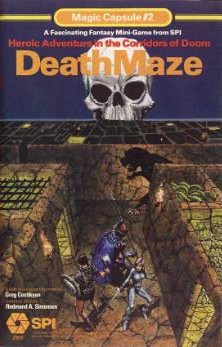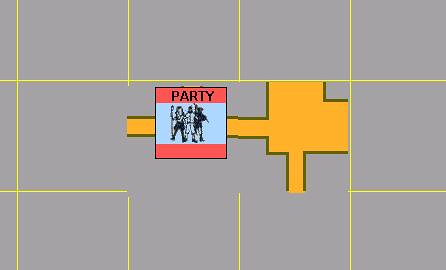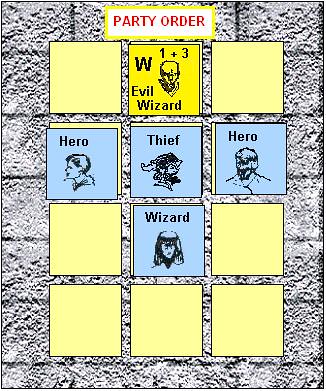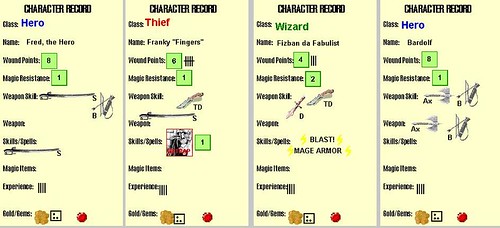9:13 AM
PBeM Solitaire Game, Deathmaze (SPI)
Mister Nizz

It's sharing time again
Ain't that special?I thought I'd resurrect something I used to do a while back, playing a solitaire game via PBeM, for people to laugh and jeer at.
I thought I'd resurrect playing a PBeM game for all to see. Feel free to laugh, jeer or comment along with me.
The game in question is DEATHMAZE, a pretty simple little SPI quad game in the fantasy line. Chosen for this purpose mostly because it's very easy to carry around (I have the ENTIRE game as a PDF on my memory stick, along with all the CB files, and it takes up less than 30K). I've greatly enhanced the gamebox I created for this thing two years ago because trying to actually play a game with it revealed quite a few weaknesses. When you are replicating a physical game that requires a tracking stuff on a sheet, you have to create the sheet, and some form of marking on it. Version 2.0 of the Deathmaze has new character sheets, markers, and various stuff to make the record keeping more interactive.
So, step one, for those that want to play along, the requisite files are in PDF and Cyberboard. That's the Deathmaze 2.0 gamebox, the basic GSN to setup a game, with my four sample characters, Fred, Franky, Fizban and Bardolf in it, and the current Walt-DM game file. These files are available on my static home page, about midway down the page where you see the Deathmaze cover. I will periodically upload the CURRENT GAME FILE so you can see a turn-by-turn replay of the current game, should you choose to.
You'll need the most current version of Cyberboard to play, there are links to it at the PBeM Emporium, which I run.
Setting up and running a game.
Fortunately, Cyberboard keeps a handy log of all of your actions during a current turn. In my first turn, we explored a bit, discovered a new room, and it had an angry Evil Wizard in it. We got into a scrap, and we pig piled him to get him down to the point where he could not cast a spell without kiling himself. At this point, it's his ONE knife against our THREE swords, so we killed him quickly. A decent amount of Experience Points and Treasure was our reward.
The Game Log, Turn One
At least for the first few reports, I will cite pertinent rules sections. These will be highlighted in RED. This marker "«--------------------»" represents a break in the action where I go to check a rule or something.
Game Log Starts
First things first. Draw a Corridor Chit, place anywhere on the map and put the party marker on top of it. The party enters the dungeon.
«--------------------»
Well, that's portentious. Corridor North? and East? (it really doesn't matter what direction is down here).
hmmm it would appear that there are two ROOMs here. Here is the pertinent rule:
[5.23] Each time the party leaves any Segment (Corridor or Room) through a door, a Player draws a Room chit from the Room cup and places it adjacent to the door the party just went through. Some of the chits in the Room cup are marked Corridor, with a corridor configuration; if one of these chits is drawn, throw it back into the Room cup, draw a chit from the Corridor cup, and use it instead of a Room chit. (If the Corridor cup is empty, chits marked Corridor may be used instead.) If then a Corridor chit with no doors should be drawn, this corridor chit may be placed with one of its open ends abutting the door the party has exited. Note: If a chit has previously been drawn for a Segment the party wishes to enter, no new chit is drawn. If the party exits a door into an area for which no chit has been drawn and that new area abuts on an open, previously drawn Corridor segment, draw a Corridor chit (despite the fact that the party is moving through a door).
«--------------------»
Explore further?
Nah, let's barge into the room and see what happens.
«--------------------»
Move is plotted.
First, we check for traps per rule 5.26
[5.26] Each time the party moves into a new Cor- ridor or Room Segment, a Player must: a) deter- mine whether the party moved through a Trapped door (assuming they moved through a door); and b) whether there are any monsters in the new Cor- ridor or Room Segment. If the party moved through a door, roll 1D6. If a 1 is rolled, the door was Trapped; see the Trap rules, 10.0. After any Traps have been dealt with, a Player determines whether there are any monsters.
Here's the roll:
DICE ROLL: Specification = 1D6 Result = 2 No Traps!
Monsters... we have not yet visited this room.
[5.27] If the segment is a Corridor, or a Room that the party has previously visited, roll 1D6. On a roll of 1, the segment contains wandering monsters. Refer to Monsters and Negotiations, 7.0. If the segment is a Room that has not been visited previ- ously, roll 1D6. On a roll of 1, 2, or 3, there is a Room monster. See 7.0.
Here's the roll:
DICE ROLL: Specification = 1D6 Result = 2 MONSTAHHHHH!!!!
«--------------------»
Let's see who we are fighting!
«--------------------»
Rolling for ROOM MONSTERS,table 7.4
First roll is across: DICE ROLL: Specification = 1D6 Result = 2 Second, Down DICE ROLL: Specification = 1D6 Result = 1 An Evil Wizard, eh?
«--------------------»
Makes more sense to resolve it on here. (note: I meant "It makes more sense to resolve this combat on the Party Order map, pictured below"
Aha! In the interregnum. I have found the missing sections on wizards. Man, being a wizard sucks! You have to expend hit points to cast spells. How do you get GOOD at being a wizard, then? Ouch!!!
Anyhoo. I was close, but no cigar when it came to making up the Wiz.
Fizban has HP4, MR2, and can default to ONE spell, or TWO if he sacrifices his other skill setup thing.
So let's make some changes before I take on the evil wizard.
(Note: I make changes to Fizban's character sheet to make him consistent with the rules)
«--------------------»
Two spells maximum at start. Considering the casting cost, I'm picking cheap ones!
«--------------------»
Back to the fight. We opened up a room, and found the Evil Wizard. One of them.
HP 4 MR 2 Spell: Lightning.
Rules text: In the Advanced Game, Evil Wizards may be encountered as monsters. In addition to having the abilities listed on the Monster Characteristics Table (see 7.5), Evil Wizards know one spell; Lightning. If a party fights an Evil Wizard, the Evil Wizard will cast Lightning every Monster Combat Phase, unless doing so would cause the Wizard to die, in which case the Wizard will fight with a dagger. Determine which adventurer the Wizard casts the spell at according to the same procedure that is used to determine which adventurer a monster attacks (see 8.33). The adventurer may attempt to resist the spell.
So I infer that the Evil Wiz also pays the one hit point price...
«--------------------»
Combat Phase:
Some helpful text:
[8.2] COMBAT SEQUENCE
[8.21] Combat between the party and a group of monsters consists of a number of Combat Rounds, each of which is divided into several Phases. At the end of each Combat Round, a new Combat Round is begun, until either the party or the monsters are dead. The Combat Round Sequence is as follows:
[8.22] Party Combat Phase: Each member of the party who is in the front row may attack a monster in the monsters' front row. Any party members in the second row who have bows or throwing daggers may shoot their bows or throw their daggers at monsters in the monsters' front row. (In the Advanced Game, any spell-casting by Wizards also take place now). Combat results are applied immediately.
[8.23] Monster Combat Phase: Each monster in the front row may attack a party member in the party's front row. Any monster in the second row who have bows may attack party members in the party's front row.
[8.24] Party Reorganization Phase: A Player may move one adventurer from one row in the party's marching order to another adjacent row in the marching order. However, at the end of this movement, no row may contain more than three adventurers. If the party's front row contains one or zero adventurers, one (only) adventurer from the second row (if any) must be moved into the front row.
[8.25] Monster Reorganization Phase: If the monsters' front row contains fewer than three monsters, one monster from the second row (if there is a second row) must be moved into the front row. No other monster movement may take place.
[8.3] OPPONENTS
[8.31] If during a Party Combat Phase there are as many monsters in the monster front line as adventurers in the party's front line, each adventurer in the front line must attack his opposite number ?i.e., the monster immediately in front of him. During the Monster Combat Phase, the monsters will also attack their opposite numbers.
[8.32] If during a Party Combat Phase there are more or fewer adventurers in the party's front line than monsters in the monsters' front line, each adventurer in the front line must attack the monster that is closest to him. If there are two or more monsters that are equally close to an adventurer, a Player may have the adventurer attack either monster.
«--------------------»
Round 1, Party Combats the Wizard dude.
Fred, the Hero, attacks the Wizard guy with a sword. Fred has Sword Skill plus one
Helpful text:
[8.43] To resolve an adventurer's attack, determine what weapon he is using. Refer to his Character Record, and roll 1D6. If the character has Weapon Skill with the weapon he is using (e.g., is wielding a sword and has "+1 Sword" under Weapon Skill on his Record), add the Skill to the die-roll. If the adventurer is wielding a magical weapon, add the weapon's Combat Bonus to the die-roll. Refer to the Combat Results Table (see 8.7) and find the weapon along the top of the table and the modified die-roll along the left side. Crossreference the two to yield a result. This result will be in the form of a number between 0 and 4. (Results are explained in Case 8.45).
Rolling: DICE ROLL: Specification = 1D6 + 1 Result = 5 [+ 1] = 6 Result: 1 wound for the Wiz. Too bad for you!
Now Franky Fingers attacks. He has no extra skill, since he's a thief (he's more interested in de-trapping)
DICE ROLL: Specification = 1D6 Result = 3 No wounds for the Wiz.
Now Bardolf bats last in the lineup
He has the extra skill point.
DICE ROLL: Specification = 1D6 + 1 Result = 1 [+ 1] = 2 Oops.
Oh heck.
Well, decision time. Burn a hp spelling this guy?
Ah why not. He's only down 1.
Roll versus Magic Resistance of 2
Eyeeees of an elephant!!!
Here's a BLAST on yo' ASS!
DICE ROLL: DICE ROLL: Specification = 1D6 Result = 3
Fortunately, I beat his MR. by one point.
So.. 2 Pts.!
Player Combat part of Round One done.
«--------------------»
HEre's the thing.. Mister wiz doesn't have enough points left to cast a spell.
So.. I guess in the Monster Phase, he can only attack physically.
I guess, he has a dagger or something.
His best shot is the thief.
DICE ROLL: Specification = 1D6 Result = 6 1 point down on Franky!
Monster combat ends.
Both counters adjust. See the comments on the counters.
«--------------------»
ROUND TWO...
Bardolf attacks, he has a plus one. A little faster this time.
DICE ROLL: Specification = 1D6 + 1 Result = 5 [+ 1] = 6 1 HP. That's it for you!
The Wiz dies.
«--------------------»
Experience...
4 Hps (Wizard) times 1D6
DICE ROLL: Specification = 1D6 Result = 6 24. Divided by 4 is 6 again.
«--------------------»
Treasure: J/C (from table 9.81, cross referencing Evil Wizards)
«--------------------»
Hmmm.. treasure type says "J/C".
Here's some helpful text from 9.11:
[9.11] After the party kills a group of monsters (or, sometimes, after successful negotiation with them), a Player must determine what sort of treasure the monsters were guarding or carrying. Refer to the Monster Characteristics Chart (see 7.5), and cross-reference the monster type with the Treasure column of the Chart. This will yield either a single letter or two letters separated by a slash. If it is a single letter, the letter is the Treasure Type of the monsters. If there are two letters, the first letter is the Treasure Type for the monsters that were rolled for on the Room Monster Table, and the second is the Treasure Type for monsters that were wandering (i.e., if they were rolled for on the Wandering Monster Table).
So it's Treasure type J. Look, even MORE helpful text:
[9.12] Refer to the Treasure Table (see 9.81). Find the letter corresponding to the monster's Treasure Type along the left side of the table. There are three columns to the Table ? Bezants, Gems, and Magic Items. Under each column on the Treasure Type's row will be a number followed by a colon followed by a die-roll code
(e.g., "3:lD6x5"). For each column (Bezants, Gems, and Magic Items) roll 1D6. If the number rolled is equal to or less than the number indicated before the colon in the appropriate column, then roll the dice again, as specified by the die-roll code after the colon, to determine the number of Bezants, Gems, or Magic Items. If the number rolled is greater than the first number, there is no treasure of that type present
Checking for Bezants: DICE ROLL: Specification = 1D6 Result = 2 Well, that's equal or less than 6, so we find 1D6 x 20
DICE ROLL: Specification = 1D6 Result = 6 Wheee! 6 x 20.. I knew I should have created a "Hundreds" symbol in my counting markers. dang!
120 bez, devided by 4, that's 30 each.
Gems; know I have to beat a two
DICE ROLL: Specification = 1D6 Result = 5 Nope, no gems. Properly, that's NOT beat a 2...
Now for Magic Items. I have to equal or be lower than a 3
DICE ROLL: Specification = 1D6 Result = 5 Nope. Still, we got 30 bez each!
«--------------------»
And that's it for this turn. Next turn we'll decide to go back the way we came or continue West.
I made the requisite changes on the player sheets.
END OF LOG


